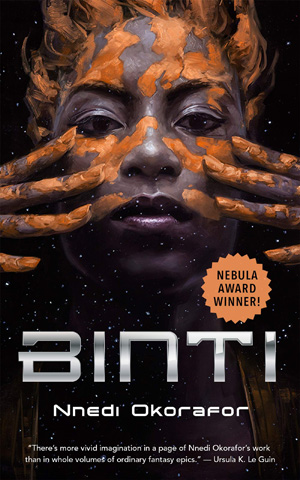The Future Is Home
Probably a short review today, so we’ll take a fast look at Binti by Nnedi Okorafor.

The tale stars a teenager named Binti, a member of the (somewhat fictionalized) Himba people of Southern Africa at an unspecified point in the future. The Himba traditionally cover their skin and hair with otjize, a mixture of butterfat, ochre pigments, and aromatic plants, as a combination of sunscreen, insect repellent, and cleansing agent. Binti’s people consider otjize an almost religious sacrament, preferring to wear it at all times. The Himba also prefer to stay close to home — in the novella, no Himba have ever left Earth at all, despite space travel being fairly commonplace.
Binti is a mathematical genius and is expected to take over her father’s business creating electronic astrolabes — but she’s secretly accepted admission to the prestigious Oomza University, located on a distant planet. She sneaks away from home, boards her flight off-world, and starts making friends, slowly, with her future classmates. It’s not an entirely smooth process — even among other African tribes, the Himba are considered unusually standoffish and weird, thanks to all the otjize, but Binti slowly begins getting acquainted with people.
And that’s when the Meduse attack.
The Meduse are jellyfish-like aliens, hostile to almost everyone, and they tend to prefer to shoot first and ask questions never. Can Binti survive the attack, learn to communicate with the Meduse, and convince them to embrace peace before her ship arrives at Oomza University?
Verdict: A very enthusiastic thumbs up. This was a pretty short novella — just around 100 pages — but I had a lot of fun with it. It reads quickly, the action is sparse, but well-done, and the concepts Okorafor is playing with — mathematics, African futurism, communication, and some level of mysticism — are excellently done. Binti is a glorious character, both traditional and conservative, and forward-thinking and radical at the same time.
Binti’s interactions with the Meduse aliens, particularly the one called Okwu, are also very well-done. These scenes are very tense, with both sides slowly coming to understand each other — although whether any reconciliation between the two sides is possible is hard to say.
I thought it was particularly cool that Okorafor was able to use a science fiction novella set in the far future to respectfully bring attention to the real-world Himba people. Binti is treated like an alien by almost every Earthling she meets because of the Himba’s isolation and customs, so perhaps she’s the perfect person to make friends with cultures even more alien.
FYI, Okorafor has turned out to be one of my favorite authors, and I plan to review at least a few more of her books eventually.
“Binti” won the Hugo and Nebula Awards for Best Novella. It has two sequels — “Binti: Home,” focusing on Binti’s homecoming to Earth, and “Binti: The Night Masquerade,” which puts a capper on Binti’s journey. You can buy all three novellas separately, though there’s also a collected edition. You should get ’em and read ’em.
Comments off
